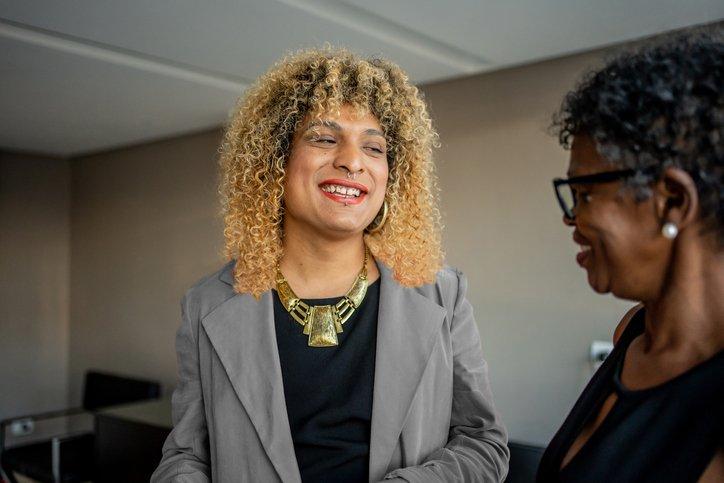
Imagine the following situation:
You serve as the Director of Operations for a renowned technology startup located in the heart of Silicon Valley. One Monday morning, as you are sipping your coffee and preparing for the week ahead, you receive an unannounced visit from your HR Manager, Anna.
During the meeting, Anna explains that one of your most skilled software engineers, who you know as Christian, is on journey of gender transition and will now be going by Christina.
This unexpected announcement will, no doubt, be an adjustment for your organization. It is also clear that accommodating Christina’s transition will require thoughtful planning and support.
You stand firm on your company’s values related to diversity, equity, and inclusion. You also recognize the need to ensure a smooth transition process for Christina while maintaining a respectful and supportive work environment for all employees. What should the next steps for the company be?
In today’s business environment, there is a growing recognition among organizations of the crucial significance of fostering workplaces that deeply embrace the principles of diversity, equity, and inclusion.
A critical facet of this commitment revolves around extending unwavering support to individuals who are undergoing a gender transition. In fact, supporting these individuals is not a matter of compassion; it is, indeed, a strategic imperative in today’s increasingly diverse workplaces.
When supporting employees during their transition, organizations demonstrate a commitment to fostering a workplace where everyone can thrive. This support will, no doubt, contribute to enhanced employee well-being and productivity since individuals who feel supported and respected in their gender identity are more likely to be engaged and perform at their best.
This commitment can also help attract and retain diverse talent, which is crucial in today’s competitive job market. It will improve the organization’s public image and reputation and it will send a clear message to clients, customers, and partners that it not only values diversity but that it is also dedicated to creating an inclusive environment for all. In an era where consumers increasingly seek to align with socially responsible brands, this can translate into increased brand loyalty and market share for the organization.
Simply put, supporting those undergoing gender transition is not just a moral imperative but also a strategic choice that benefits individuals and organizations alike.
Understanding the Gender-Transition Journey
The journey of transitioning from an assigned gender to another is a profoundly personal experience, and its particulars can vary greatly from one individual to another.
When transitioning from male to female, for example, the process may encompass a range of elements including gender counseling, electrolysis, voice training, hormone therapy, facial feminization surgery, and genital surgery.1 In cases where hormone therapy doesn’t yield the desired results in breast development, some individuals may opt for breast augmentation surgery.
We also need to understand that not everyone follows the same trajectory. The steps people take can diverge significantly based on factors such as personal preferences, cultural attitudes, resource availability, and medical and legal considerations. Regardless of the path chosen, though, the support of medical professionals, therapists, and a robust network of friends and family plays a pivotal role in the lives of those embarking on this transformative journey.
One important thing to remember is that this is a deeply personal journey rooted in genuine desire to live as one’s authentic selves, and it is not driven by a passing curiosity about a different lifestyle.
Gender Transition Barriers and Solutions
Organizations today find themselves at a pivotal juncture where their policies and practices wield profound influence over the well-being and trajectories of their workforce.
Here, I will explore some of the barriers those transitioning face. I will also list a few compelling ways organizations can provide support.
1. Lack of Understanding and Awareness
The lack of awareness and understanding regarding gender transition in the workplace remains a significant issue today. Many employees and employers may not fully comprehend the complexities and challenges that individuals undergoing gender transitions face. This lack of awareness can lead to misgendering, discrimination, and a hostile work environment, negatively impacting the mental and emotional well-being of transgender employees.
What organizations can do: Taking a proactive stance, organizations can implement regular diversity training sessions aimed at educating employees about gender diversity, transgender experiences, and the importance of using respectful language and behavior. Through continuous education, employees become better equipped to communicate with sensitivity and engage in thoughtful interactions, fostering an inclusive environment where every individual is valued and respected for their authentic selves.
2. Discrimination and Bias
Concerns related to encountering discrimination, bias, or even hostility from colleagues, clients, or supervisors can significantly elevate stress and anxiety levels. The fear of being unfairly treated because of one’s gender identity can weigh heavily on an individual.
Needless to say, discrimination and bias can erode employees’ sense of belonging and self-worth, making it challenging for them to perform at their best in the workplace. In fact, the emotional toll of experiencing discrimination or hostility can have far-reaching consequences, affecting overall job satisfaction, engagement, and physical health as well as mental and emotional well-being.
What organizations can do: First of all, leaders can be instrumental in nurturing a culture of inclusion by consistently articulating and exemplifying the expected conduct. Through their actions, they underscore the organization’s dedication to creating a secure and respectful environment. In fact, when leaders actively champion and uphold these principles, they set a precedent that reinforces an atmosphere of acceptance for all employees.
In addition, establishing robust anti-discrimination policies that clearly outline repercussions for discriminatory actions plays a pivotal role in fostering a fair and inclusive workplace. These policies send a clear message that discrimination will not be tolerated.
3. Misgendering and Deadnaming
“Deadnaming” is calling a transgender person by their birth name when they have changed their name as part of their gender transition. Persistently using incorrect names and pronouns can inflict profound distress and have a cascading effect on an individual’s overall well-being, ultimately undermining their performance in the workplace.
Beyond the immediate emotional impact, this practice can erode an individual’s sense of self-identity and self-worth, leading to feelings of exclusion and alienation. These feelings can, in turn, result in increased stress, anxiety, and reduced job satisfaction, which can significantly hinder an employee’s ability to focus and excel in their role. Furthermore, the mental and emotional energy expended on coping with misgendering can divert their attention away from productivity and innovation, thus diminishing an employee’s contributions to the organization.
What organizations can do: To create a more inclusive workplace environment, organizations can take proactive steps by promoting the adoption of chosen names and pronouns. This can be achieved through awareness initiatives, such as workshops and informational campaigns, emphasizing the importance of respecting individuals’ gender identities. Additionally, encouraging employees to include their name and pronouns in email signatures can help normalize their usage. The integration of technology, such as profile management systems, further streamlines this process, allowing individuals to easily update their names and pronouns within the organization’s records. By doing so, they ensure that accurate and respectful information is consistently used in all communication and documentation throughout the organization.
4. Different Religious and Cultural Beliefs
Colleagues’ cultural or religious perspectives can occasionally come into conflict with the acceptance of gender diversity, giving rise to the potential for tension or discrimination within the workplace. This conflict may stem from deeply held beliefs and traditions that vary significantly across cultures and religious affiliations. While diversity and inclusion efforts aim to create an equitable and accepting environment, it is essential to recognize that differing worldviews can sometimes create friction.
What organizations can do: Foster an environment that promotes open dialogues and respectful discussions concerning cultural and religious beliefs in the context of gender diversity. The critical objective is to establish spaces where all employees feel comfortable sharing their viewpoints, raising questions, and expressing concerns without the fear of facing negative consequences. One effective approach is to create a trained diversity task force that is able to facilitate these discussions and serve as intermediaries in resolving conflicts that may emerge.
5. Microaggressions
The accumulation of subtle, everyday behaviors or comments that convey insensitivity or bias can, over time, significantly contribute to creating an unwelcoming and challenging environment for individuals undergoing gender transition. These microaggressions, though often unintentional, can manifest themselves as misgendering, derogatory remarks, or even dismissive attitudes, and they collectively serve to undermine people’s sense of inclusion and acceptance. Such experiences can lead to heightened stress, anxiety, and emotional exhaustion for transgender employees, making it difficult for them to focus on their work and perform to their full potential.
What organizations can do: It is imperative to incorporate discussions on microaggressions into the organization’s training programs as a cornerstone for nurturing a more inclusive and respectful workplace culture. By placing a strong emphasis on the importance of mindful communication and behavior, these programs enable employees to discern the impact of their words and actions and how they can inadvertently marginalize and harm individuals. This approach not only enhances awareness but also empowers organizations to cultivate an environment where every voice is appreciated, thereby promoting understanding and empathy across diverse identities and experiences.
Additional Thoughts
Recognizing and understanding these barriers is a pivotal step for leaders and HR professionals to take, as it enables them to proactively dismantle obstacles and foster a workplace culture that genuinely embraces gender diversity and supports individuals during their transition.
Leaders can set the tone by actively championing inclusion and modeling respectful behavior, thereby signaling to the entire organization that gender diversity is not only accepted, but must be respected.
Additionally, HR professionals play a critical role in implementing comprehensive policies and support mechanisms, such as gender transition guidelines, anti-discrimination measures, and educational programs that help raise awareness and foster understanding among all employees.
By taking these proactive steps, organizations can create a more supportive and inclusive environment for all individuals, regardless of their gender identity or expression. This not only benefits those undergoing gender transitions but also contributes to a workplace culture characterized by empathy, respect, and openness. Overall, it underscores that diversity and inclusion are not just buzzwords but essential principles that drive positive change and progress within the workplace.
In part two of this article, I will share steps organizations can take to ensure they are ready to support those transitioning in the workplace. You will also hear advice from individuals who have led their organizations through this type of experience, and I will provide you with additional resources. Subscribe to The Inclusion Solution here to ensure you are notified of part two!


















